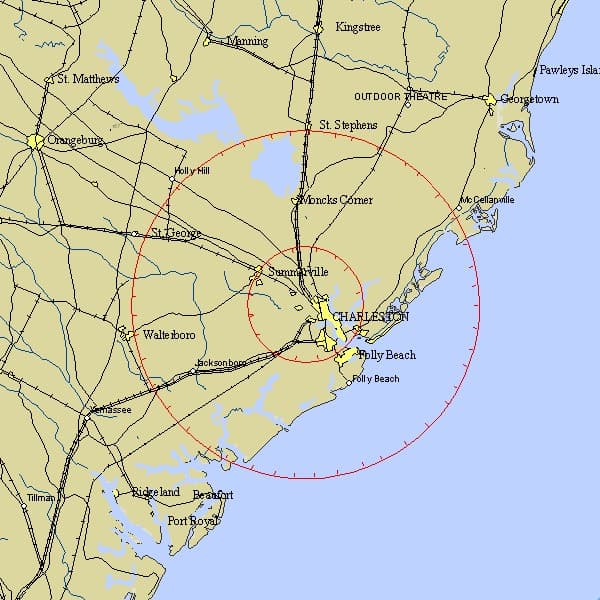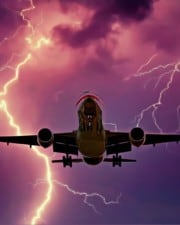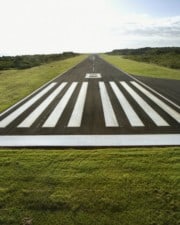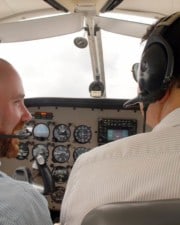After 9/11, there was one significant change in aviation that all pilots became very familiar with. It’s changed the way they prepare for flights and made situational awareness even more critical than it always has been. Let’s talk about what role TFRs play in this.
A TFR is a temporary flight restriction. TFRs are issued by NOTAM (Notice to Airmen) and only appear for specific reasons. The biggest concern for pilots is the fact that a TFR can pop up without much warning. Pilots must check for their presence before every flight.
Reasons for TFRs
Temporary Flight Restrictions are issued by a NOTAM before they become active. The NOTAM produces an area of special use airspace with special regulations. TFRs are issued under the Federal Aviation Regulations (FARs) Parts 91.137 through 91.145 and Part 99.7. Each regulation deals with a specific type of TFR with a particular purpose.
91.137 and 91.138
FAR Parts 91.137 and 91.138 deal with flight restrictions around disaster areas. These TFRs are put into effect after events like hurricanes, earthquakes, wildfires, or aircraft crashes. They limit air traffic in and out of an area for the safety of rescuers and those being aided. 91.138 is specifically for disasters in the State of Hawaii.
91.139
Rule 91.139 established TFRs during emergency air traffic procedures. It was under this rule that all flights were grounded after the events of September 11, 2001. This was the first and only time this rule was implemented on a national scale.
91.141
Part 91.141 is of particular interest to pilots since it is the most problematic and the hardest to work around. 91.141 allows for the creation of a TFR in the proximity of the President and other VIP parties. Since these people move around the country (especially during campaign season), the VIP TFR roams around and moves hour-to-hour.

91.143
91.143 is established for spaceflight operations. These are found during launches from areas like Cape Canaveral, Florida and Vandenberg Air Force Base, California.
91.145
FAR Part 91.145 creates TFR over significant sporting events and aerial demonstrations, like major airshows. The primary purpose of these TFRs is to provide space for authorized aircraft to work.
99.7
Separately, FAR 99.7 allows the FAA to designate certain areas of airspace as sensitive to national security. These areas are often found near areas of military bases or operations, large cities during events like political conventions, and very high-profile events like the Super Bowl and NASA’s manned space launches. These are sites that are considered potential targets of terrorism and therefore require more protection.
This regulation has also been used to create several “permanent” temporary flight restrictions that are, for all intents and purposes, areas of prohibited or restricted airspaces.
The most prominent examples include the Special Air Regulations zone around Washington DC, as well as some small areas over popular attractions, like Disney World in Florida and Disneyland in California.
General Rules and Exceptions
Because each TFR is different, it’s impossible to make any blanket statements about what is allowed and what is not. TFRs range from wholly prohibited entry to all flights merely needing to be in contact with ATC to transit.
It can be said, regardless of the type or location of the TFR, that it is not a good idea to fly into one as a VFR flight squawking 1200. Flights on instrument flight plans from Point A to Point B are the most likely flights to be allowed in and near TFRs. Training flights and “round-robin” flight plans are generally not allowed.
Special rules always apply, and the pilot must understand and comply with those rules in each instance. When in doubt, it’s better to scrub the flight than to risk enforcement action. Talking directly to an FSS briefer may help clarify the confusion.

The size of different TFRs also varies dramatically. Disaster and hazardous area TFRs are generally small and extend up only a few hundred feet. Presidential TFRs, on the other hand, are often complex.
The outer zone of these TFRs often extends 30 nm. The inner region, usually defined by a 10 nm radius, is more restrictive. It is generally a prohibited area for all flights.
TFRs for the Vice President are often much smaller, usually with a three-mile radius. All VIP TFRs roam around as the VIP moves, so the dimensions and location can fluctuate hour-to-hour.
Strategies to Avoid TFRs
Given the variable nature of TFRs, it puts a heavy responsibility on the pilot to avoid them. FAR 91.103 states, “Each pilot in command, shall, before beginning a flight, become familiar with all available information concerning that flight.”
In order to meet this requirement, every pilot must double-check TFR restriction before every flight. Since TFRs change rapidly and can pop up quickly, knowing where they are and how to avoid them is of the utmost importance.
It remains the sole responsibility of the pilot in command to be familiar with all aspects affecting the flight. The Pilot In Command (PIC), therefore, has a legal obligation to check for any known and published TFRs that may concern them.
The unfortunate thing is that TFR information is seldom presented in a quick and easy to read manner. Many pilots have faced enforcement action because, while they knew a TFR was in existence, they misunderstood the parameters of it.
With this in mind, the responsibility of the PIC then becomes two-fold. They must know if a TFR exists, and have a mitigation strategy to avoid it. To do that effectively, having a one-on-one conversation with a flight briefer is one of their best options. The flight briefer should be able to discuss the TFR and explain the detailed language found in the NOTAM.
Plot It On Paper
Another essential tool for understanding the dimensions of the TFR is to plot it on a paper chart manually. Not only does this allow the pilot to clearly define the limits of the TFR airspace in their minds, but it also requires careful studying of the FAA NOTAM.
Numerous websites feature a flight restrictions map, including the Flight Service website. In today’s digitally connected cockpits, many pilots use electronic flight bags (EFBs), multifunction displays (MFDs), and tablets. Many of these programs automatically overlay TFRs onto digital charts, but it’s still the PIC’s responsibility to ensure that that information is current and accurate.
Give a Wide Berth
It’s also prudent to give TFRs the widest berth possible. If you are proceeding on a VFR cross country flight, there is no reason to be any closer than 15 or 20 miles away from it. If a slight detour can put miles between the aircraft and the TFR boundaries, it should be done. The pilot should keep in mind how their flight looks to a controller watching on radar. The last thing they want to do is make it look suspicious by flying towards or very near a TFR.
Request ATC Service
Finally, if operating anywhere near a TFR area, it’s prudent to request air traffic control services. If on a VFR flight, pick up VFR flight following. If you can, go ahead and file and activate an IFR flight plan. This is a final piece of insurance to make sure you comply with the TFRs restrictions. Do not hesitate to ask the controller for clarification on the situation.
In the circumstance of a presidential TFR, the military will actively be monitoring the airspace. If not in ATC contract, it is wise to monitor the guard frequency on 121.50 MHz. This is where intercept aircraft will be trying to reach problem aircraft.
Importance of Legal Preflight Briefings
There are many sources for TFRs, including the FAA’s website. Unfortunately, most of these methods do not record evidence that the pilot ever checked. If the worst happens and a pilot busts airspace that they were unaware of, it will become vitally important that the pilot prove they received a briefing and met their legal obligations.
There are only a few ways to receive a legal preflight briefing. Some record must be made, with the pilot’s name or tail number. When a pilot calls Flight Service at 1-800-WX-BRIEF for a weather briefing, one or the other is required. When a pilot logs into the Flight Service website, their login information contains the same record.
Enforcement Actions
Being regulatory in nature, a pilot who is found to have breached a TFR will be guilty of a pilot deviation. At the least, this will result in an investigation by the FAA and possible enforcement action. At worst, it can mean being intercepted mid-air by military aircraft and forced to land.
Intercept procedures are outlined in the Aeronautical Information Manual Section 5-6-2. Once returned to the airport, the flight will likely be met by law enforcement.
Related Posts













